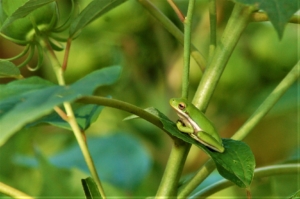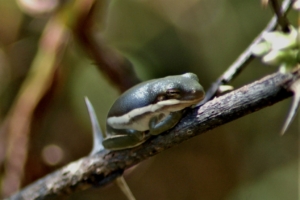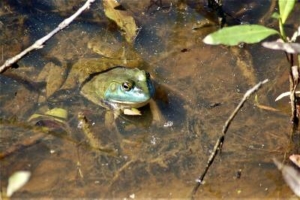That Blue Frog Craze! Again?
All photos by Jerry Nissley
We all remember the ‘blue frog’ craze from last summer, right?

Normal color Green Tree Frog
Well I certainly do. All the specimens I found were axanthic green tree frogs (Hyla cinerea). But this is a new year folks! Today I found a bullfrog (Lithobates catesbeianus) exhibiting these traits. I get excited about stuff like this and I always like to share my excitement with others. Here is a quick overview of what I know. There is a ton of published information out there if you want to dig deeper.

Type 1
Axanthism in its basic description is a genetic mutation that inhibits the animal’s ability to produce yellow pigments. There are three types of axanthism in amphibians: 1. complete to partial blue coloration due to a lack of yellow pigmentation, 2.

Type 2
complete or partial dark coloration, and 3. normal coloration with black eyes. These are not distinct categories, and there can be amphibians that have a combination of these.
Type one is most common in the frog family (Ranidea) which is also the family that happens to be most commonly affected by axanthism. In my research, I could not find a community consensus as to why axanthism occurs in amphibians; whether it is genetic or environmental. There are persuasive arguments on both sides.

Bullfrog with blue nose
Axanthism seems to be most prevalent in North America and is more common in Northern regions; but if last summer is a trend, it is sliding quickly into the southeastern states. Axanthism is most common in frogs, with salamanders and newts having almost no cases.
So be on the look out for this very cool frog morph – it’s a eureka moment to spot one!




